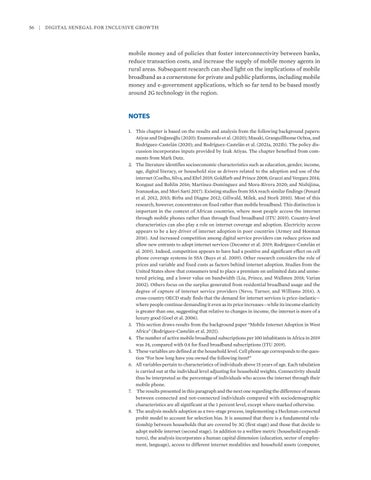56
| Digital Senegal for Inclusive Growth
mobile money and of policies that foster interconnectivity between banks, reduce transaction costs, and increase the supply of mobile money agents in rural areas. Subsequent research can shed light on the implications of mobile broadband as a cornerstone for private and public platforms, including mobile money and e-government applications, which so far tend to be based mostly around 2G technology in the region.
NOTES 1. This chapter is based on the results and analysis from the following background papers: Atiyas and Doğanoğlu (2020); Enamorado et al. (2020); Masaki, Granguillhome Ochoa, and Rodríguez-Castelán (2020); and Rodríguez-Castelán et al. (2021a, 2021b). The policy discussion incorporates inputs provided by Izak Atiyas. The chapter benefited from comments from Mark Dutz. 2. The literature identifies socioeconomic characteristics such as education, gender, income, age, digital literacy, or household size as drivers related to the adoption and use of the internet (Coelho, Silva, and Ehrl 2019; Goldfarb and Prince 2008; Grazzi and Vergara 2014; Kongaut and Bohlin 2016; Martínez-Domínguez and Mora-Rivera 2020; and Nishijima, Ivanauskas, and Mori Sarti 2017). Existing studies from SSA reach similar findings (Penard et al. 2012, 2015; Birba and Diagne 2012; Gillwald, Milek, and Stork 2010). Most of this research, however, concentrates on fixed rather than mobile broadband. This distinction is important in the context of African countries, where most people access the internet through mobile phones rather than through fixed broadband (ITU 2019). Country-level characteristics can also play a role on internet coverage and adoption. Electricity access appears to be a key driver of internet adoption in poor countries (Armey and Hosman 2016). And increased competition among digital service providers can reduce prices and allow new entrants to adopt internet services (Decoster et al. 2019; Rodríguez-Castelán et al. 2019). Indeed, competition appears to have had a positive and significant effect on cell phone coverage systems in SSA (Buys et al. 2009). Other research considers the role of prices and variable and fixed costs as factors behind internet adoption. Studies from the United States show that consumers tend to place a premium on unlimited data and unmetered pricing, and a lower value on bandwidth (Liu, Prince, and Wallsten 2018; Varian 2002). Others focus on the surplus generated from residential broadband usage and the degree of capture of internet service providers (Nevo, Turner, and Williams 2016). A cross-country OECD study finds that the demand for internet services is price-inelastic— where people continue demanding it even as its price increases—while its income elasticity is greater than one, suggesting that relative to changes in income, the internet is more of a luxury good (Goel et al. 2006). 3. This section draws results from the background paper “Mobile Internet Adoption in West Africa” (Rodríguez-Castelán et al. 2021). 4. The number of active mobile broadband subscriptions per 100 inhabitants in Africa in 2019 was 34, compared with 0.4 for fixed broadband subscriptions (ITU 2019). 5. These variables are defined at the household level. Cell phone age corresponds to the question “For how long have you owned the following item?” 6. All variables pertain to characteristics of individuals above 15 years of age. Each tabulation is carried out at the individual level adjusting for household weights. Connectivity should thus be interpreted as the percentage of individuals who access the internet through their mobile phone. 7. The results presented in this paragraph and the next one regarding the difference of means between connected and not-connected individuals compared with sociodemographic characteristics are all significant at the 1 percent level, except where marked otherwise. 8. The analysis models adoption as a two-stage process, implementing a Heckman-corrected probit model to account for selection bias. It is assumed that there is a fundamental relationship between households that are covered by 3G (first stage) and those that decide to adopt mobile internet (second stage). In addition to a welfare metric (household expenditures), the analysis incorporates a human capital dimension (education, sector of employment, language), access to different internet modalities and household assets (computer,



